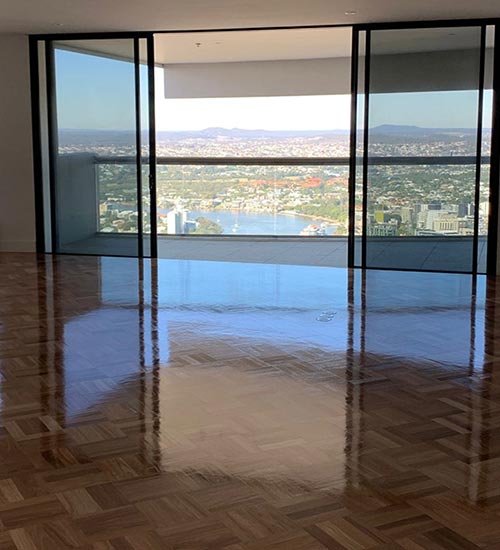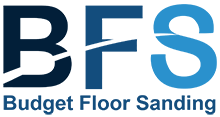| Question |
Answer (What it is/does) |
| What is invisible protect? |
Invisible Protect is a new water-based timber floor coating that retains the natural appearance and feel of untreated timber. |
| What’s new in it? |
Its almost invisible layer is extremely scratch-resistant and the wood floor coating has outstanding wear resistance. There is no enhancement of the timber color and the original floorboard color is retained. Invisible Protect also has an Anti-slip rating of R9. |
| Where can it be applied? |
This floor product is suitable for cork, parquetry, and interior wooden floors. Loba’s Invisible Protect is the latest from Germany’s technology leader in environmentally friendly, waterborne timber floor polishes. |
What Are The Exterior Timber Deck Polishes for Brisbane’s Climate?
As Brisbane’s climate is perfect for outdoor living, Budget Floor Sanding Brisbane regularly maintains, recoats, and restores timber decks. We also have a specialized long-nosed edging machine to reach in under your handrails to complete a professional deck restoration.
The timber polish on outdoor timber decks does not last as long as interior polishes due to the harsh ultraviolet light it receives. If decks are not maintained, the polish deteriorates and eventually flakes off leaving the raw timber deck exposed and vulnerable to timber rot. Damaged timber boards can lead to the timber deck needing a more expensive repair or replacement.
Restore your deck to its absolute best with Brisbane’s deck sanding specialists, Budget Floor Sanding Brisbane.
Get a Free Quote Call: 0418 882 678
Frequently Asked Questions About Timber Floor Finishes and Polishing Brisbane
What are the different categories of interior timber floor finishes?
Interior finishes are categorized into four basic classes based on their “base” and finishing effect: oil-based finishes, composite oil-based/solvent-based finishes, solvent-based polyurethane finishes, and water-based finishes.
What are the advantages and disadvantages of oil-based timber floor finishes?
Advantages: Oil-based finishes provide a warm and high-tone effect, and they have excellent coverage. They also give the wooden floor a beautiful satin appearance.
Disadvantages: Oil-based finishes require more maintenance, as they do not wear well. With age, the wood may darken and possibly yellow in darker areas or where it is covered. Edge bonding of the floorboards is unlikely.
How do composite oil-based/solvent-based interior floor finishes differ from pure Tung oil-based finishes?
Composite oil-based/solvent-based finishes combine natural oils with urethanes to enhance wear qualities. They offer greater durability compared to pure Tung oil-based finishes. Gloss levels can vary from high gloss to satin. Water-based versions with low VOC emissions are also available but at a higher cost.
What are the characteristics of solvent-based polyurethane floor finishes?
Solvent-based polyurethane provides the hardest finish among the four alternatives. It has excellent wear qualities and requires little maintenance. Gloss levels range from matt to very high gloss. The finish darkens with age, and there is a strong odor during application, which dissipates as it dries. Edge bonding of the floorboards can occur due to their high strength and limited flexibility.
Are water-based floor finishes a better option for those with respiratory issues?
Yes, water-based finishes are a better option for those with respiratory issues. They produce fewer fumes and have lower VOC emissions compared to solvent-based finishes. Water-based finishes cure faster and are environmentally friendly, providing improved durability and wear qualities.
How do water-based floor finishes compare to solvent-based finishes in terms of curing time and fumes?
Water-based finishes cure faster than solvent-based finishes. They produce fewer fumes during application and have lower VOC emissions. This makes water-based finishes a suitable choice if you need to stay in your home while the floor sanding and polishing process is being done.
What are the benefits of using raw untreated Scandinavian-looking timber floors with invisible protect?
Raw untreated Scandinavian-looking timber floors with invisible protect retain the natural appearance and feel of untreated wood. The almost invisible layer is extremely scratch-resistant, providing outstanding wear resistance. The original floorboard color is retained, and it has an anti-slip rating. This option is suitable for cork, parquetry, and interior.
Where can invisible protect be applied, and what are its features?
Invisible protect, a water-based coating, can be applied to cork, parquetry, and interior wooden floors. It retains the natural appearance and feel of untreated timber while offering exceptional scratch resistance, wear resistance, and an anti-slip rating of R9.
What are the common coating materials used for exterior timber deck finishes?
Common coating materials for exterior finishes include Sikkens Deck, a premium oil-based coating that offers excellent weather resistance and allows the wood grain to remain visible, and Decking Oil, an economical option that requires more frequent applications.
How long do exterior timber deck finishes last, and what happens if they are not properly maintained?
The longevity of deck finishes is influenced by various factors such as the quality of the coating, exposure to sunlight, weather conditions, and maintenance. Generally, exterior finishes do not last as long as interior finishes due to the harsh ultraviolet light they receive. If deck finishes are not properly maintained, the finish can deteriorate over time. This can result in flaking off, leaving the raw wooden deck exposed and vulnerable to rot. Damaged boards may require more expensive repairs or even replacement. It is essential to regularly maintain, recoat, and restore timber decks to ensure their longevity and preserve their aesthetic appeal. Professional deck sanding specialists, like Budget Floor Sanding Brisbane, have the expertise and specialized equipment to perform deck restoration effectively.
Are timber floor finishes pet-friendly and safe for children?
Yes, most timber floor finishes are safe for children and pets after the curing time has passed. It is better to opt for finishes with low VOCs in the house with pets and children. Water-based finishes are particularly suitable as they emit fewer VOCs, but it’s best to keep children and pets off the floor during the curing period.
How soon after polishing can I walk on the floor?
The minimum time to use or to walk after polishing with a water-based finish is 24 hours. Oil-based finishes require a longer drying time, often up to 48 hours or more. Avoid placing or dragging household items on the freshly cured floors for a week.
What are VOCs, and what is their role in floor finishes?
Volatile Organic Compounds (VOCs) are chemicals emitted as gases from certain finishes, especially oil-based products. High-VOC finishes pollute indoor air and cause serious breathing problems. Water-based finishes have low VOCs, making them a popular choice in Brisbane homes.
Get a Free Quote Call: 0418 882 678
Save
Save
Save

